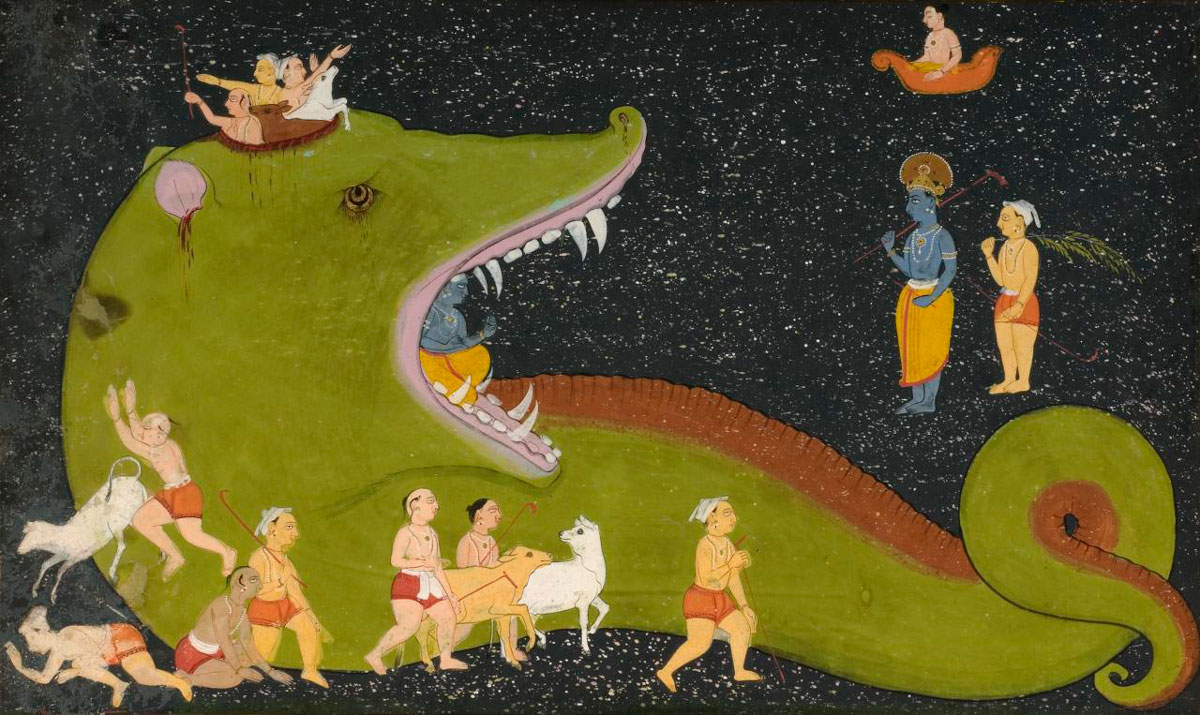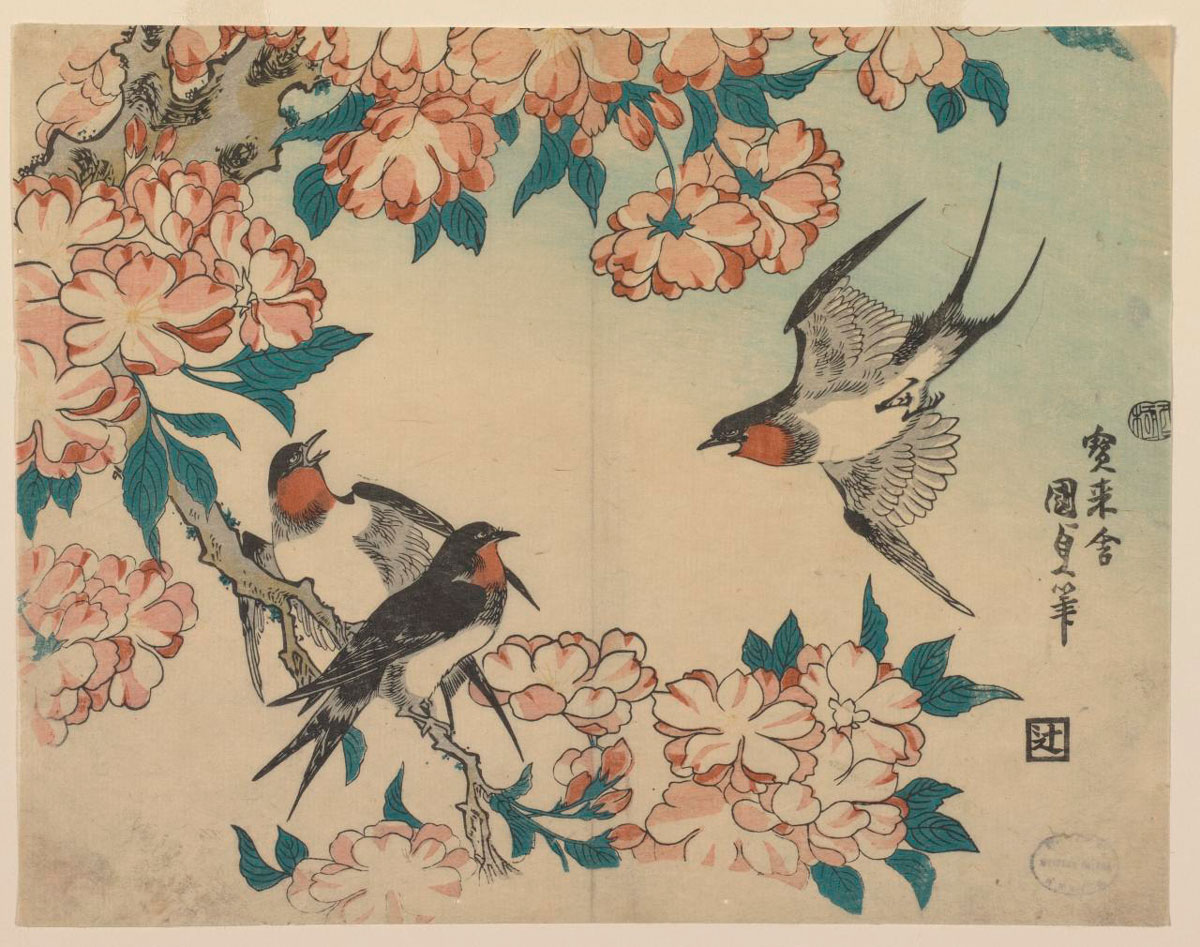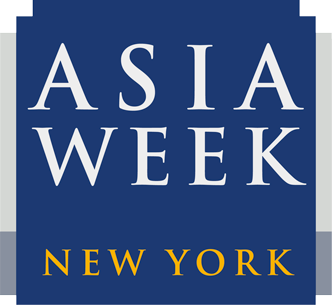
Mewar School, Indian, ca. 1600 – 1900, Krishna’s Victory Over Aghasura, early 18th century, watercolor and gold on paper, 9 3/4 x 15 5/8 in. (24.77 x 39.69 cm); Purchase: William Rockhill Nelson Trust, 60-34
Sages and Heroes: Storytelling in Asian Art
April 12, 2025 – January 4, 2026
Gallery 222
Storytelling is a vital part of many Asian cultures. The works in this gallery were created by Japanese, Chinese, Burmese, Indian, Persian, and Armenian artists from the 1200s to 1800s. Drawing inspiration from Asian literature, religion, and history, these artists enliven stories with their dynamic visual narratives.
Visual storytelling comes alive via the artists’ skillful hands. Their portrayals convey each story’s intent to entertain, provide advice, promote a set of beliefs, or commemorate people or events. Similarly, the artists’ choices of format and material enhance the viewing experience in public or private. These treasures from the museum’s collection connect us to the joy of storytelling through art.
To learn more, click here.

Aries (Mangala), from a series of Astrological Paintings, Indian, about 1810. Opaque watercolor and gold on paper, 7 3/4 × 6 inches (19.69 × 15.24 cm). The Nelson-Atkins Museum of Art, Gift of Wayne and Nancy Hunnicutt, 2019.63.1.
Mapping the Heavens: Art, Astronomy, and Exchange between the Islamic Lands and Europe
December 14, 2024 – January 11, 2026
Where are we? When are we?
These fundamental questions drove the development of astronomical sciences and religious practices across different times, regions, and faiths, to map and understand our place in the world and its relationship with the heavens.
The story of Mapping the Heavens begins in the Islamic World during the Early Middle Ages (c. 500s – 1200s CE), where Muslim scientists preserved and advanced the study of astronomy. Access to these scientific texts– many collected and translated in Spain in the 1200s and widely disseminated in books after the invention of the printing press in the 1400s–fueled a revolution of new discoveries and created a shared astronomical knowledge across Europe.
The works presented in this exhibition introduce the advancement of astronomy as a multi-cultural and multi-faith dialogue between scholars and scientists, showcasing the beauty and importance of the books, instruments, and images that communicated these discoveries.
Mapping the Heavens is part of our World Religions Initiative at The Nelson-Atkins Museum of Art. This exhibition is co-organized with the Linda Hall Library and generously supported by the Lilly Endowment Inc.
To learn more, click here.
RECENTLY CLOSED EXHIBITION

Utagawa Kunisada (Japanese, 1786–1864), Cherry Blossoms and Three Swallows, 1800s, woodblock print; ink and color on paper, 8 ¾ x 11 1/8 in. (22.2 x 28.3 cm); The Nelson-Atkins Museum of Art, Purchase: William Rockhill Nelson Trust, 32-143/219
Lasting Impressions: The Art of Japanese Woodblock Prints
April 5 – July 13, 2025
Gallery 205
For over 1,200 years, woodblock printing has been a vital force in Japanese art, giving artists a powerful means to create multiple impressions of nearly identical works. In woodblock printing, artists cut images and patterns into wooden blocks, creating shapes and lines they can ink and print numerous times. This technique’s ability to reproduce images made it essential for spreading ideas and cultural values across centuries. This exhibition highlights 38 woodblock prints created between 770 C.E. and 1970s, alongside paintings and carved woodblocks, highlighting the evolution of techniques and themes in Japanese art.
To learn more, click here.
PERMANENT COLLECTIONS
Chinese
The Chinese art collection is one of the finest collections in the West with more than 7,000 works from every phase of China’s artistic activity.
Bronzes and Jades: Ancient Chinese bronzes and jades include celebrated pieces such as a hu wine vessel of the Shang Dynasty (16th century—1046 B.C.E) and a ritual jade disc of the 3rd century B.C.E.
Chinese Painting Collection: The collection of Chinese paintings is one of the most important outside Asia, particularly in the 10th through 13th centuries, and includes masterworks such as Xu Daoning’s Fisherman’s Evening Song, and Li Cheng’s A Solitary Temple Amid Clearing Peaks.
Buddhist Sculpture and Wall Paintings: Buddhist sculpture and wall paintings range from the 5th to 18th centuries. A jewel of the museum is the Chinese Temple Gallery (Gallery 230), which displays a 12th-century polychrome wooden figure of Guanyin of the Southern Sea, heralded as the finest sculpture of its kind outside China.
Chinese Furniture, Ceramics and Textiles: The museum was a pioneer in the collecting of Chinese furniture and is famed for its Ming (1368–1644) and early Qing (1644–1911) hardwood furniture. The ceramics collection includes tomb sculptures, stonewares and porcelains that chronicle the great epochs of Chinese ceramic innovations. The collection also includes more than 500 silk textiles dating from the 2nd century B.C.E. to the 20th century.
To learn more, click here.
Japanese
The Japanese collection contains more than 2,000 works of art from the 7th century C.E. to the early 20th century.
Screens and Scrolls: The strength of the collection lies in its folding paper screens from the 16th to early 20th century. Paramount among the screens is the sublime pair Pine and Plum by Moonlight by Kaihō Yūshō and the elegant River Landscape with Fireflies by Shiokawa Bunrin. Hanging scrolls and illustrations supplement the collection: Tawaraya Sōtatsu’s Illustration from Tale of Ise and Ikeno Taiga’s Impressive View of the Go River show the breadth and versatility of the Rimpa and Nanga school masters.
Woodblock Prints: A portfolio of more than 500 color woodblock prints of the Edo period contains examples of all the famous ukiyoe masters, including Katsushika Hokusai and Utagawa Hiroshige.
Ceramics and Sculpture: An impressive array of ceramics is dominated by the spectacular 16th-century Echizen Water Jar whose monumentality is complemented by the bold natural ash glaze. Completely different in terms of scale and embellishment are the subtle tea bowls favored for the tea ceremony and a selection of Kutani and Nabeshima porcelains.
Sculpture features primarily Buddhist images in wood from the Heian (794-1185) and Kamakura (1185-1333) periods, while textiles include 18th and 19th century Nō robes and priests’ kesa.
To learn more, click here.
South & Southeast Asian
The Nelson-Atkins has more than 1,100 objects of South and Southeast Asian art, Himalayan art and Islamic art from West Asia.
The collection represents a wide range of art forms, including sculpture, ceramics, textiles, metalwork, and works on paper that date from the 3rd century B.C.E. to the 21st century C.E.
The collection began with the acquisition of Southeast Asian sculptures and more than 300 Persian and Indian textiles from the van Nemes collection in 1931.
In the original 1933 installation, these works were presented in two period rooms, a “Persian Room” and the “Hindu Temple Room,” which is still in place where the Indian galleries are today.
South and Southeast Asian Art and Islamic Art: Sculpture is one of the great strengths of the collection, which features excellent examples of stone, bronze and metal sculpture from India, Nepal, Tibet, ancient Gandhara (modern Pakistan and Afghanistan) and peninsular Southeast Asia. The museum also is home to a small but significant collection of works on paper representing the Persian, Mughal and Rajput traditions.
Gifts and Recent Acquisitions: Significant highlights include the purchase of two folios from the Mughal Gulshan Album 1948 and the gift of nearly 150 Tibetan and Nepalese sculptures, thangkas and ritual objects through the bequest of Joseph H. Heil in 1974.
Recent acquisitions include a sculpture of Shiva and Parvati gifted by Dr. Roopa Bansal, a Jain manuscript, drawings and furniture from Colonial-era India and examples of contemporary Islamic-inspired art.
To learn more, click here.

